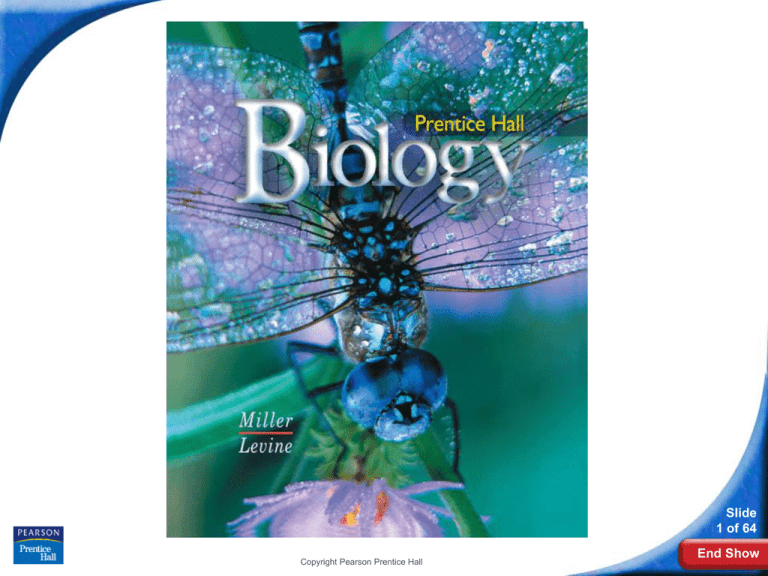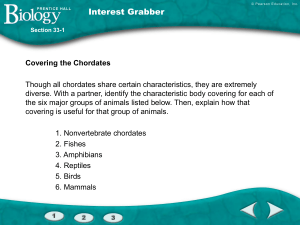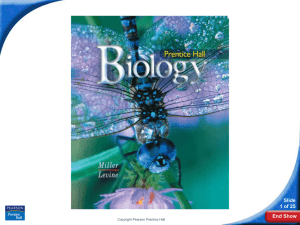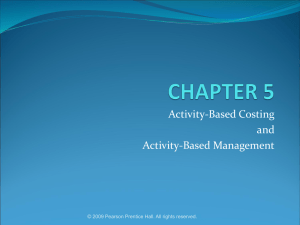
Biology
Slide
1 of 64
Copyright Pearson Prentice Hall
End Show
33-3 Form and Function
in Chordates
Slide
2 of 64
Copyright Pearson Prentice Hall
End Show
33-3 Form and Function in Chordates
Chordates
Nonvertebrate chordates alive today represent a
simple, ancient stage in the development of chordate
body systems.
Slide
3 of 64
Copyright Pearson Prentice Hall
End Show
33-3 Form and Function in Chordates
Chordates
Vertebrate organ systems exhibit a wide range of
complexity.
Adaptive radiations produced specialized organ
systems that perform essential functions and
maintain homeostasis.
The complexity of organ systems is seen in the
different ways that vertebrates feed, breathe,
respond, move, and reproduce.
Slide
4 of 64
Copyright Pearson Prentice Hall
End Show
33-3 Form and Function in Chordates
Feeding
Feeding
Feeding and digestion help maintain homeostasis
by providing the body with nutrients.
Skulls and teeth of vertebrates are adapted for
feeding on a variety of foods.
Slide
5 of 64
Copyright Pearson Prentice Hall
End Show
33-3 Form and Function in Chordates
Feeding
How do the digestive systems of the
different groups of vertebrates compare?
Slide
6 of 64
Copyright Pearson Prentice Hall
End Show
33-3 Form and Function in Chordates
Feeding
The digestive systems of vertebrates have
organs that are well adapted for different
feeding habits.
Carnivores have short digestive tracts with
fast-acting, meat-digesting enzymes.
Herbivores have long intestines. Some have
bacteria that help digest the tough cellulose
fibers in plant tissues.
Slide
7 of 64
Copyright Pearson Prentice Hall
End Show
33-3 Form and Function in Chordates
Feeding
Vertebrate Digestive Systems
Shark
Salamander
Lizard
Slide
8 of 64
Copyright Pearson Prentice Hall
End Show
33-3 Form and Function in Chordates
Feeding
Vertebrate Digestive Systems
Pigeon
Cow
Slide
9 of 64
Copyright Pearson Prentice Hall
End Show
33-3 Form and Function in Chordates
Feeding
How do the respiratory systems of the
different groups of chordates compare?
Slide
10 of 64
Copyright Pearson Prentice Hall
End Show
33-3 Form and Function in Chordates
Respiration
Respiration
Aquatic chordates—such as tunicates,
fishes, and amphibian larvae—use gills
for respiration.
Land vertebrates, including adult
amphibians, reptiles, birds, and
mammals, use lungs.
Slide
11 of 64
Copyright Pearson Prentice Hall
End Show
33-3 Form and Function in Chordates
Respiration
Some chordates have respiratory structures in
addition to gills and lungs.
Bony fishes have accessory organs such as simple
air sacs.
Lancelets respire by diffusion of oxygen across their
body.
Many adult amphibians use moist skin and the lining
of their mouths and pharynxes to respire by diffusion.
Slide
12 of 64
Copyright Pearson Prentice Hall
End Show
33-3 Form and Function in Chordates
Respiration
Gills
As water passes over the gill filaments, oxygen
molecules diffuse into blood in tiny blood vessels
called capillaries.
At the same time, carbon dioxide diffuses from
blood into the water.
Slide
13 of 64
Copyright Pearson Prentice Hall
End Show
33-3 Form and Function in Chordates
Respiration
Water flows in through
the fish’s mouth. Muscles
pump the water across
the gills
Mouth
Slide
14 of 64
Copyright Pearson Prentice Hall
End Show
33-3 Form and Function in Chordates
Respiration
Each gill contains
thousands of filaments
that absorb oxygen from
the water.
Gill filament
Slide
15 of 64
Copyright Pearson Prentice Hall
End Show
33-3 Form and Function in Chordates
Respiration
Operculum: Water and carbon dioxide are pumped
out through the operculum.
Operculum
Slide
16 of 64
Copyright Pearson Prentice Hall
End Show
33-3 Form and Function in Chordates
Respiration
Lungs
Although the structure of the lungs varies, the
basic process of breathing is the same among land
vertebrates.
Slide
17 of 64
Copyright Pearson Prentice Hall
End Show
33-3 Form and Function in Chordates
Respiration
Inhaling brings oxygen-rich air from outside the body
through the trachea and into the lungs. Oxygen
diffuses into the blood inside the lung capillaries.
Carbon dioxide diffuses out of the capillaries into the
air within the lungs. Oxygen-poor air is then exhaled.
Slide
18 of 64
Copyright Pearson Prentice Hall
End Show
33-3 Form and Function in Chordates
Respiration
Vertebrate Respiration
Salamander
Lizard
Slide
19 of 64
Copyright Pearson Prentice Hall
End Show
33-3 Form and Function in Chordates
Respiration
Vertebrate Respiration
Primate
Bird
Slide
20 of 64
Copyright Pearson Prentice Hall
End Show
33-3 Form and Function in Chordates
Respiration
The surface area of lungs increases as you move
from the amphibians to mammals.
The amphibian lung is little more than a sac with
ridges.
Reptilian lungs are divided into a series of large and
small chambers that increase the surface area for
gas exchange.
Slide
21 of 64
Copyright Pearson Prentice Hall
End Show
33-3 Form and Function in Chordates
Respiration
In mammals, the lungs branch, and their entire
volume is filled with bubblelike structures called
alveoli.
Alveoli provide an enormous surface area for gas
exchange.
This enables mammals to take in the large amounts
of oxygen required by their endothermic metabolism.
Slide
22 of 64
Copyright Pearson Prentice Hall
End Show
33-3 Form and Function in Chordates
Respiration
In birds, air flows in only one direction. A system of
tubes, plus air sacs, enables one-way air flow.
Gas exchange surfaces are constantly in contact with
fresh air that contains a lot of oxygen.
This enables birds to fly at high altitudes, where there
is less oxygen in the atmosphere than at lower
altitudes.
Slide
23 of 64
Copyright Pearson Prentice Hall
End Show
33-3 Form and Function in Chordates
Circulation
How do the circulatory systems of the
different groups of chordates compare?
Slide
24 of 64
Copyright Pearson Prentice Hall
End Show
33-3 Form and Function in Chordates
Circulation
Circulation
Circulatory systems maintain homeostasis by
transporting materials throughout animals’ bodies.
Slide
25 of 64
Copyright Pearson Prentice Hall
End Show
33-3 Form and Function in Chordates
Single-loop
circulatory system
Fishes
Circulation
Double-loop circulatory system
Most reptiles
Crocodilians, birds,
and mammals
Slide
26 of 64
Copyright Pearson Prentice Hall
End Show
33-3 Form and Function in Chordates
Circulation
Single- and Double-Loop Circulation
Chordates that use gills for respiration have a
single-loop circulatory system.
In this system, blood travels from the heart to the
gills, then to the rest of the body, and back to the
heart in one circuit.
Slide
27 of 64
Copyright Pearson Prentice Hall
End Show
33-3 Form and Function in Chordates
Circulation
Gill capillaries
1 Ventricle
Heart
1 Atrium
Body capillaries
FISHES
Slide
28 of 64
Copyright Pearson Prentice Hall
End Show
33-3 Form and Function in Chordates
Vertebrates with lungs
have a double-loop
circulatory system.
Circulation
Lung capillaries
2 Atria
1 Ventricle with
partial division
Heart
Body capillaries
Most reptiles
Copyright Pearson Prentice Hall
Slide
29 of 64
End Show
33-3 Form and Function in Chordates
The first loop carries
blood between the
heart and lungs.
Oxygen-poor blood
from the heart is
pumped to the lungs.
Oxygen-rich blood from
the lungs returns to the
heart.
Circulation
Lung capillaries
2 Atria
1 Ventricle with
partial division
Body capillaries
Most reptiles
Copyright Pearson Prentice Hall
Heart
Slide
30 of 64
End Show
33-3 Form and Function in Chordates
The second loop
carries blood between
the heart and the body.
Oxygen-rich blood from
the heart is pumped to
the body.
Oxygen-poor blood
from the body returns
to the heart.
Circulation
Lung capillaries
2 Atria
1 Ventricle with
partial division
Body capillaries
Most reptiles
Copyright Pearson Prentice Hall
Heart
Slide
31 of 64
End Show
33-3 Form and Function in Chordates
Circulation
Heart Chambers
During the course of chordate evolution,
the heart developed chambers and
partitions that help separate oxygen-rich
and oxygen-poor blood traveling in the
circulatory system.
Slide
32 of 64
Copyright Pearson Prentice Hall
End Show
33-3 Form and Function in Chordates
In vertebrates with gills, such as
fishes, the heart consists of two
chambers:
•
an atrium that receives blood
from the body
•
a ventricle that pumps blood
to the gills and then on to the
rest of the body
Circulation
1 Ventricle
1 Atrium
Slide
33 of 64
Copyright Pearson Prentice Hall
End Show
33-3 Form and Function in Chordates
Circulation
Most amphibians have three-chambered
hearts.
• The left atrium receives oxygen-rich
blood from the lungs.
• The right atrium receives oxygen-poor
blood from the body.
• Both atria empty into the ventricle,
which directs blood flow.
Slide
34 of 64
Copyright Pearson Prentice Hall
End Show
33-3 Form and Function in Chordates
Circulation
Most reptiles have a threechambered heart.
2 Atria
Unlike amphibians, most
reptiles have a partial
partition in their ventricle
that reduces the mixing of
oxygen-rich and oxygenpoor blood.
1 Ventricle with
partial division
Slide
35 of 64
Copyright Pearson Prentice Hall
End Show
33-3 Form and Function in Chordates
Birds, mammals, and
crocodilians have fourchambered hearts
sometimes called a
double pump.
Circulation
2 Atria
One pump moves blood
through the lung loop and
the other moves blood
through the body loop.
2 Ventricles
completely divided
Slide
36 of 64
Copyright Pearson Prentice Hall
End Show
33-3 Form and Function in Chordates
The two loops are
separated. Therefore,
oxygen-rich and oxygenpoor blood do not mix.
Circulation
2 Atria
2 Ventricles
completely divided
Slide
37 of 64
Copyright Pearson Prentice Hall
End Show
33-3 Form and Function in Chordates
Excretion
Excretion
Excretory systems eliminate nitrogenous wastes.
In nonvertebrate chordates and fishes, gills and gill
slits play an important role in excretion.
Most vertebrates rely on kidneys—excretory
organs composed of small filtering tubes that
remove wastes from the blood.
Slide
38 of 64
Copyright Pearson Prentice Hall
End Show
33-3 Form and Function in Chordates
Excretion
Nitrogenous wastes are first produced in the form of
ammonia.
Ammonia is highly toxic. Therefore, it must quickly be
eliminated from the body or changed into a less
poisonous form.
Slide
39 of 64
Copyright Pearson Prentice Hall
End Show
33-3 Form and Function in Chordates
Excretion
In tunicates, ammonia leaves the body through the
outflow siphons.
Other waste byproducts are stored within the
tunicate’s body and released only when the animal
dies.
Slide
40 of 64
Copyright Pearson Prentice Hall
End Show
33-3 Form and Function in Chordates
Excretion
In vertebrates, excretion is carried out mostly by the
kidneys.
Aquatic amphibians and most fishes also excrete
ammonia from gills into the water through diffusion.
Mammals, land amphibians, and cartilaginous fishes
change ammonia into urea before it is excreted.
In reptiles and birds, ammonia is changed into uric
acid.
Slide
41 of 64
Copyright Pearson Prentice Hall
End Show
33-3 Form and Function in Chordates
Excretion
In addition to eliminating nitrogenous wastes,
kidneys help maintain homeostasis by regulating
the amounts of water, salt, and other substances
dissolved in body fluids.
Slide
42 of 64
Copyright Pearson Prentice Hall
End Show
33-3 Form and Function in Chordates
Response
How do the nervous systems of the
different groups of chordates compare?
Slide
43 of 64
Copyright Pearson Prentice Hall
End Show
33-3 Form and Function in Chordates
Response
Response
Nonvertebrate chordates have a
relatively simple nervous system with a
mass of nerve cells that form a brain.
Vertebrates have a more complex brain
with distinct regions, each with a
different function.
Slide
44 of 64
Copyright Pearson Prentice Hall
End Show
33-3 Form and Function in Chordates
Response
Nonvertebrate chordates do not have specialized
sensory organs.
Vertebrates display a high degree of cephalization, or
concentration of sense organs and nerve cells at the
front of the body.
The head contains a well-developed brain, which is
situated on the anterior end of the spinal cord.
Slide
45 of 64
Copyright Pearson Prentice Hall
End Show
33-3 Form and Function in Chordates
Response
The vertebrate brain is
divided into several parts:
• cerebrum, or
“thinking and
learning” region
• cerebellum, which
coordinates
movement and
balance
Slide
46 of 64
Copyright Pearson Prentice Hall
End Show
33-3 Form and Function in Chordates
Response
• medulla oblongata,
which controls many
internal organs
• optic lobes, which
are involved in vision
• olfactory bulbs,
which are involved in
smell
Slide
47 of 64
Copyright Pearson Prentice Hall
End Show
33-3 Form and Function in Chordates
Response
The size and complexity of the cerebrum and
cerebellum increase from fishes to mammals.
Bony Fish
Amphibian
Reptile
Bird
Mammal
Slide
48 of 64
Copyright Pearson Prentice Hall
End Show
33-3 Form and Function in Chordates
Response
Vertebrate Brains
Bony Fish
Amphibian
Olfactory bulb
Cerebellum
Cerebrum
Medulla oblongata
Optic lobe
Spinal cord
Copyright Pearson Prentice Hall
Slide
49 of 64
End Show
33-3 Form and Function in Chordates
Response
Vertebrate Brains
Reptile
Bird
Mammal
Olfactory bulb
Cerebellum
Cerebrum
Medulla oblongata
Optic lobe
Spinal cord
Copyright Pearson Prentice Hall
Slide
50 of 64
End Show
33-3 Form and Function in Chordates
Movement
How do the skeletal and muscular systems
of the different groups of chordates
compare?
Slide
51 of 64
Copyright Pearson Prentice Hall
End Show
33-3 Form and Function in Chordates
Movement
Movement
Unlike most chordates, nonvertebrate chordates
lack bones.
Nonvertebrate chordates, however, do have
muscles.
Lancelets and larval tunicates swim with a fishlike
movement of their muscular tails.
Slide
52 of 64
Copyright Pearson Prentice Hall
End Show
33-3 Form and Function in Chordates
Movement
The skeletal and muscular systems
support a vertebrate's body and make it
possible to control movement.
Slide
53 of 64
Copyright Pearson Prentice Hall
End Show
33-3 Form and Function in Chordates
Movement
Most vertebrates have an internal skeleton of bone or
cartilage.
The skeleton includes a backbone of individual bones
called vertebrae.
Ligaments connect vertebrae and allow the backbone
to bend.
Most vertebrates have fin or limb girdles that support
fins or limbs.
Slide
54 of 64
Copyright Pearson Prentice Hall
End Show
33-3 Form and Function in Chordates
Movement
In many fishes and snakes, the main body muscles
are arranged in blocks on either side of the
backbone. These muscles generate forward thrust.
In many amphibians and reptiles, limbs stick out
sideways from the body in a position resembling a
push-up.
Most mammals stand with their legs straight under
them, a position that supports body weight efficiently.
Slide
55 of 64
Copyright Pearson Prentice Hall
End Show
33-3 Form and Function in Chordates
Reproduction
Reproduction
Almost all chordates reproduce sexually.
Vertebrate evolution shows a general trend from
external to internal fertilization.
Eggs of nonvertebrate chordates—and many
fishes and amphibians—are fertilized externally.
Eggs of reptiles, birds, and mammals are fertilized
internally.
Slide
56 of 64
Copyright Pearson Prentice Hall
End Show
33-3 Form and Function in Chordates
Reproduction
After fertilization, the development of chordates can
be:
• Oviparous—eggs develop outside the mother’s
body.
• Ovoviviparous—eggs develop within the
mother’s body, but are born alive.
• Viviparous—developing embryos obtain
nutrients directly from the mother’s body and are
born alive.
Slide
57 of 64
Copyright Pearson Prentice Hall
End Show
33-3 Form and Function in Chordates
Reproduction
Some vertebrates, such as most amphibians,
produce many offspring but give them little care. This
reproductive strategy favors populations that disperse
and grow rapidly.
Mammals and birds produce few young but care for
them. This reproductive strategy aids survival in
crowded, competitive environments.
Slide
58 of 64
Copyright Pearson Prentice Hall
End Show
33-3
Click to Launch:
Continue to:
- or -
Slide
59 of 64
End Show
Copyright Pearson Prentice Hall
33-3
In mammals, the lungs branch extensively, and
their entire volume is filled with thousands of
bubblelike structures called
a. trachea.
b. gills.
c. alveoli.
d. air sacs.
Slide
60 of 64
End Show
Copyright Pearson Prentice Hall
33-3
In vertebrates, excretion is carried out mostly by
the
a. pancreas.
b. kidneys.
c. liver.
d. intestine.
Slide
61 of 64
End Show
Copyright Pearson Prentice Hall
33-3
As you move from fish to mammal, there is an
increase in the size of the cerebrum and
a. spinal cord.
b. cerebellum.
c. medulla.
d. ganglia.
Slide
62 of 64
End Show
Copyright Pearson Prentice Hall
33-3
Which of the following groups of organisms is
arranged in order of 2-chambered, 3chambered, and 4-chambered heart?
a. whale, salamander, fish
b. fish, adult frog, elephant
c. Adult frog, fish, human
d. bat, fish, adult frog
Slide
63 of 64
End Show
Copyright Pearson Prentice Hall
33-3
Which of the following vertebrate groups
provides most care to its young?
a. fishes
b. amphibians
c. reptiles
d. mammals
Slide
64 of 64
End Show
Copyright Pearson Prentice Hall
END OF SECTION







